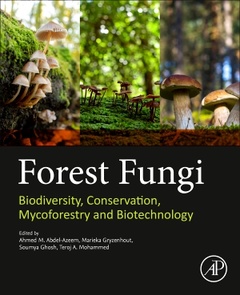Forest Fungi Biodiversity, Conservation, Mycoforestry and Biotechnology
Coordonnateurs : Abdel Azeem Ahmed M., Gryzenhout Marieka, Ghosh Soumya, Mohammed Teroj A.

2. Diversity, Phylogeny, and Taxonomic of Forest Fungal Communities
3. Forest Fungal Diversity: Review of Traditional and Molecular Techniques
4. Climate Changes and Drought challenges to Forest Fungi
5. Geographic distribution of forest fungi and their associated plant taxa
6. "Omics" Tools for Better Understanding the Plant–Fungi Interactions
7. Plant Growth-Promoting Potentials of Forest Fungi
8. Molecular Approaches to Screen Bioactive Compounds from Forest Fungi
9. In Silico Prediction and Characterization of Secondary Metabolite from Forest Fungi
10. The Insecticidal Activity of Forest Fungi for Sustainable Agriculture
11. Bioactive Compounds of Forest Fungi for Diverse Biotechnological Applications
12. Industrially Important Enzymes of Forest Fungi
13. The Chitinolytic Potentiality of Forest Fungi
14. Antimycobacterial Compounds Produced by Forest Fungi: An Overview
15. Secondary Metabolites Production by Forest Fungi
16. Forest Fungi—Alternative Sources of Cytotoxic Compounds
17. Volatile Organic Compounds from Forest Fungi
18. Anticancer and Antimicrobial Potential of Forest Endophytes
19. Forest Endophytes as Novel Sources of Plastic degradation
20. Forest Macrofungi as Novel Sources of Antioxidant Compounds
21. Alkaloids of Forest Fungi, Diversity and Therapeutic Applications
22. Forest fungi as a source of high protein.
23. Forest Fungi: Secondary Metabolism, Regulation, Function and Drug Discovery
24. Forest Fungi from the jungle to the Factory: Biodiesel Recent Developments
25. Conservation of Forest Fungi: Current situation and future perspectives
26. Industrial and Biotecchnological Application of Lignin Degrading Forest Fungi
27. Ectomycorrhizal fungi as biofertilizers in Forestry
28. Forest Fungi and White Biotechnology
29. Forest Fungi Nanotechnology and their applications
30. Forest Fungi as an Unseen Heritage and Wealth: Conclusion and Future Challenges
Dr. Marieka Gryzenhout PhD is passionate about studying fungi (mycology). Her mycology career started when she developed a world monograph of the important tree pathogen fungal family Cryphonectriaceae. Her research instilled in her a hunger to discover fungal species, describe them and untangle taxonomic problems using a practical approach and making the knowledge available to diverse end-users who do not necessarily have the appropriate skills and background. Her current position as biosystematist in the Department of Genetics at the University of the Free State, is conducive to follow her research ideals. Currently she published 85 international peer reviewed articles, three books (one has been revised and released again) and four book chapters
Dr. Soumya Ghosh is presently working as an Assistant Professor at the Natural and Medical Science Research Center, University of Nizwa, Nizwa, Oman since January, 2024. Previously, he worked as postdoctoral researcher at the Department of Genetics, University of the Free State, South Africa since September, 2019 - December, 2024. Following his
- Focuses on the biodiversity of forest fungi and their potential biotechnological application for sustainable development
- Includes high quality illustrations and figures for enhanced ease of understanding the process mechanism
Date de parution : 08-2024
Ouvrage de 550 p.
19x23.3 cm



